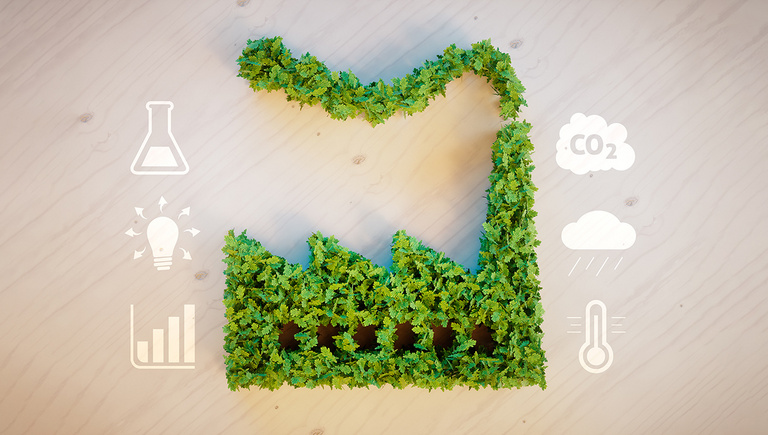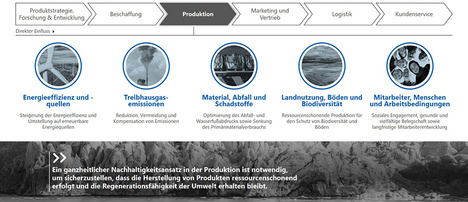
- Blog
- Published on: 15.04.2021
- 5:01 mins
Sustainability Hotspots in Production
Identifying Opportunities
Being efficient and conserving resources have always been important considerations for industrial production, though self-interest is generally the motivation. For example, the aim of lean management is to optimize the use of all resources, including materials, labor, and waste. Digitalization facilitates another boost in the form of new automation and autonomization technologies. Sustainability may not be the driving force behind these advances, but it is still a useful side effect of more efficient production processes.
Developing a modern and sustainable production scenario is a complex and substantial task: It starts with building sustainable supply chains and establishing innovative product strategies and developments, and must take into consideration production planning along with all the associated technology, logistics and shop floor management. All elements of the scenario must focus on people, materials, production plants and the environment.
To maintain this focus, production managers must ask themselves several questions: Which sustainability issues are relevant to the production sites in question? What are the negative effects of these production processes? How do we make a positive contribution to sustainable development?
MHP can offer guidance on this last point. After analyzing a range of production environments to identify potential for optimization, MHP has pinpointed the following hotspots as most relevant for sustainable development:
1. Energy Efficiency and Energy Sources
Around one third of Germany’s total energy consumption comes from the industrial sector. Approximately 90 percent of consumption is accounted for by heating requirements (67 per cent) and power requirements (22 per cent), while refrigeration, lighting and information and communication technology represent the rest (based on information from AG Energiebilanzen e.V.). It’s certainly worth noting the positive impact from the remarkable improvement in Germany’s energy productivity in recent years, as reported by the German Environment Agency. However, forecasts by the International Energy Agency predict that global energy consumption will continue to rise steadily until 2050, making it even more essential for companies to use intelligent energy management systems. This technology uncovers numerous untapped opportunities for using energy more efficiently within production plants and for consistently pressing ahead with the switch to renewable energy sources.
2. Greenhouse Gas Emissions
Let’s look at the good news first: Smoking factory towers are now a rare sight in Germany thanks to modern plant technology. The bad news is that reductions in greenhouse gas emissions from manufacturing have remained static for about 15 years according to the German Environment Agency. Production and logistics still generate enormous amounts of energy and process related GHG emissions, with chemical, metal, coal and petroleum products being the worst culprits. Given the ambitious climate targets that are now in place, the problem is only getting worse: Some of these emissions cannot be prevented through process or product optimization. The ability to make any progress on this issue depends on comprehensive investment and technological innovation through concepts such as CO2 sequestration by carbon capture and storage.
3. Materials, Waste and Pollutants
Aside from its negative contribution to climate change, industrial production has other detrimental effects on the environment – on natural habitats and water sources, for instance. Production managers must therefore spend much more time considering the impact of production-related material consumption, harmful substances, plastic packaging, waste, and fine dust. The sad anniversary of “take-make-waste” linear production models takes place every year on Earth Overshot Day (World Wildlife Fund). In 2020, all the planet’s renewable resources had already been used up by August 22. The change to concepts like a circular economy is more urgently required than ever before to break the link between rising production capacities and depletion of non-renewable resources. For production managers, this means considering extended product life cycles and enforcing the use of circular materials.
4. Land Use, Soil Quality and Biodiversity
The impact of this topic is often underestimated yet it is incredibly problematic: Massive biodiversity loss is one of the three greatest existential risks to our planet according to the World Economic Forum. Scientists warn that our oceans and rainforests are in an alarming state. Protecting land and ecosystems from industrial damage is a controversial issue even in places like Germany. Policymakers still face the familiar dilemma of weighing up economic benefits against ecological costs when considering plans to construct new battery factories and expand brown coal mining activities.
5. Employees, People and Working Conditions
As we move toward highly automated and robot-controlled processes, there is a danger that the needs of employees will increasingly be overlooked as the production environment develops. By contrast, sustainable production concepts aim to offer employees a safe and productive environment. Working conditions that consider health-related issues and psychosocial benefits can significantly improve production efficiency. As well as reducing work-related accidents and noise pollution, such environments promote equal opportunities and encourage personal development.
The Solution
These hotspots highlight the complexity of this task and the wealth of challenges that production managers will have to tackle in the future. While exploring its vision of a smart factory (our white paper is worth a read if you want to know more), MHP developed a “Smart & Sustainable Production” approach that empowers production organizations to begin a digital and sustainable transformation supported by relevant use cases.
The MHP approach begins with a comprehensive qualitative and quantitative maturity analysis. The quantitative methodology is based on tried-and-tested tools that create a transparent overview of material, process, and information flows. Then, these flows are used to identify waste, environmental impact, and automation opportunities. The resulting database helps to define the subsequent use cases. The spectrum of the analysis is deliberately very broad but can be narrowed down to account for specific focus areas. In addition to conventional metrics such as wait times or cycle times, the analysis can evaluate sustainability factors such as material footprints and energy consumption. Another additional benefit is the fact that the maturity level determined by the analysis enables continuous benchmarking.
The analysis produces a systematic overview of opportunities to optimize sustainability and digitalization services relevant to the production scenario. The results are used to create a company-specific vision that is upheld by a unique mindset – like Porsche AG’s “Factory of the Future – Smart, Lean and Green” concept – and that is integrated into a comprehensive KPI framework.
Next, the appropriate “Smart & Sustainable Production” use cases are evaluated against the weaknesses and optimization opportunities identified earlier in the process. The use cases describe specific solutions, such as integrating upstream and downstream activities horizontally along the value chain or integrating production control vertically from the field level to the management level. As well as featuring quick wins, the range of solutions primarily focuses on technological, organizational, and process related use cases.
The next steps are based on a standardized sustainable business case study to ensure that management decisions effectively consider cost, benefit, feasibility, and sustainability aspects. The resulting detailed use-case roadmap facilitates a purposeful transformation process, with scope to unlock other synergies during its implementation.
The “Smart & Sustainable Production” approach offers far more than just ecological and social added value. Sustainable production has a positive impact on employee retention, it drives innovation, attracts environmentally conscious customers, and improves the external perception of the entire company. It therefore makes an important contribution to sustainable development in several different ways.
In addition to cross-industry, cross-functional, process and technological expertise, our experience on many projects has been that a comprehensive partner network is a decisive factor when it comes to sustainable transformation in production.

